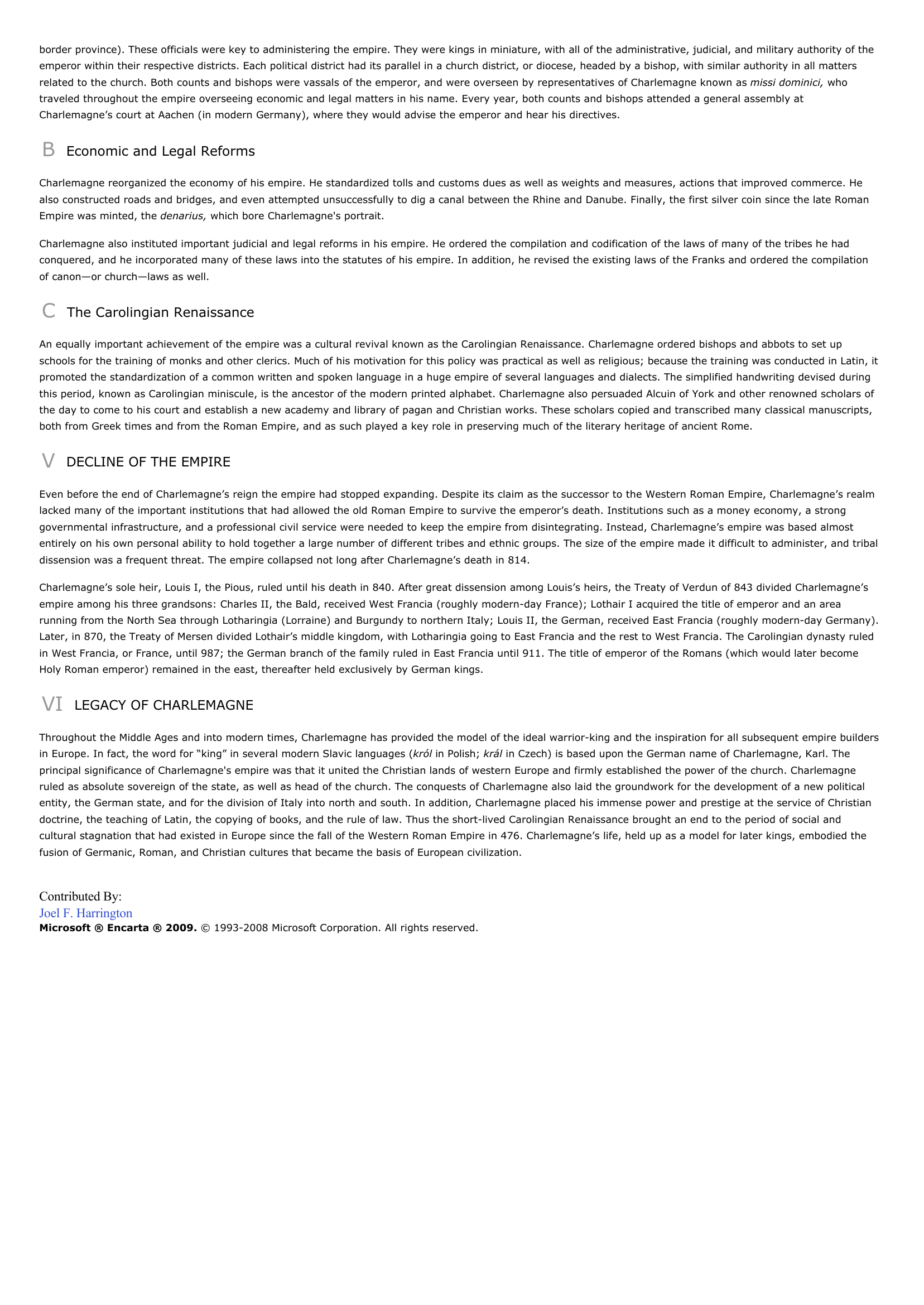Charlemagne .
Publié le 03/05/2013
Extrait du document
«
border province).
These officials were key to administering the empire.
They were kings in miniature, with all of the administrative, judicial, and military authority of theemperor within their respective districts.
Each political district had its parallel in a church district, or diocese, headed by a bishop, with similar authority in all mattersrelated to the church.
Both counts and bishops were vassals of the emperor, and were overseen by representatives of Charlemagne known as missi dominici, who traveled throughout the empire overseeing economic and legal matters in his name.
Every year, both counts and bishops attended a general assembly atCharlemagne’s court at Aachen (in modern Germany), where they would advise the emperor and hear his directives.
B Economic and Legal Reforms
Charlemagne reorganized the economy of his empire.
He standardized tolls and customs dues as well as weights and measures, actions that improved commerce.
Healso constructed roads and bridges, and even attempted unsuccessfully to dig a canal between the Rhine and Danube.
Finally, the first silver coin since the late RomanEmpire was minted, the denarius, which bore Charlemagne's portrait.
Charlemagne also instituted important judicial and legal reforms in his empire.
He ordered the compilation and codification of the laws of many of the tribes he hadconquered, and he incorporated many of these laws into the statutes of his empire.
In addition, he revised the existing laws of the Franks and ordered the compilationof canon—or church—laws as well.
C The Carolingian Renaissance
An equally important achievement of the empire was a cultural revival known as the Carolingian Renaissance.
Charlemagne ordered bishops and abbots to set upschools for the training of monks and other clerics.
Much of his motivation for this policy was practical as well as religious; because the training was conducted in Latin, itpromoted the standardization of a common written and spoken language in a huge empire of several languages and dialects.
The simplified handwriting devised duringthis period, known as Carolingian miniscule, is the ancestor of the modern printed alphabet.
Charlemagne also persuaded Alcuin of York and other renowned scholars ofthe day to come to his court and establish a new academy and library of pagan and Christian works.
These scholars copied and transcribed many classical manuscripts,both from Greek times and from the Roman Empire, and as such played a key role in preserving much of the literary heritage of ancient Rome.
V DECLINE OF THE EMPIRE
Even before the end of Charlemagne’s reign the empire had stopped expanding.
Despite its claim as the successor to the Western Roman Empire, Charlemagne’s realmlacked many of the important institutions that had allowed the old Roman Empire to survive the emperor’s death.
Institutions such as a money economy, a stronggovernmental infrastructure, and a professional civil service were needed to keep the empire from disintegrating.
Instead, Charlemagne’s empire was based almostentirely on his own personal ability to hold together a large number of different tribes and ethnic groups.
The size of the empire made it difficult to administer, and tribaldissension was a frequent threat.
The empire collapsed not long after Charlemagne’s death in 814.
Charlemagne’s sole heir, Louis I, the Pious, ruled until his death in 840.
After great dissension among Louis’s heirs, the Treaty of Verdun of 843 divided Charlemagne’sempire among his three grandsons: Charles II, the Bald, received West Francia (roughly modern-day France); Lothair I acquired the title of emperor and an arearunning from the North Sea through Lotharingia (Lorraine) and Burgundy to northern Italy; Louis II, the German, received East Francia (roughly modern-day Germany).Later, in 870, the Treaty of Mersen divided Lothair’s middle kingdom, with Lotharingia going to East Francia and the rest to West Francia.
The Carolingian dynasty ruledin West Francia, or France, until 987; the German branch of the family ruled in East Francia until 911.
The title of emperor of the Romans (which would later becomeHoly Roman emperor) remained in the east, thereafter held exclusively by German kings.
VI LEGACY OF CHARLEMAGNE
Throughout the Middle Ages and into modern times, Charlemagne has provided the model of the ideal warrior-king and the inspiration for all subsequent empire buildersin Europe.
In fact, the word for “king” in several modern Slavic languages ( król in Polish; král in Czech) is based upon the German name of Charlemagne, Karl.
The principal significance of Charlemagne's empire was that it united the Christian lands of western Europe and firmly established the power of the church.
Charlemagneruled as absolute sovereign of the state, as well as head of the church.
The conquests of Charlemagne also laid the groundwork for the development of a new politicalentity, the German state, and for the division of Italy into north and south.
In addition, Charlemagne placed his immense power and prestige at the service of Christiandoctrine, the teaching of Latin, the copying of books, and the rule of law.
Thus the short-lived Carolingian Renaissance brought an end to the period of social andcultural stagnation that had existed in Europe since the fall of the Western Roman Empire in 476.
Charlemagne’s life, held up as a model for later kings, embodied thefusion of Germanic, Roman, and Christian cultures that became the basis of European civilization.
Contributed By:Joel F.
HarringtonMicrosoft ® Encarta ® 2009. © 1993-2008 Microsoft Corporation.
All rights reserved..
»
↓↓↓ APERÇU DU DOCUMENT ↓↓↓
Liens utiles
- Voyager à travers le temps (3) : Charlemagne Découvrir 1.
- Le personnage de CHARLEMAGNE
- ESSAI SUR LES MœURS ET L’ESPRIT DES NATIONS et sur les principaux faits de l’histoire depuis Charlemagne jusqu’à Louis XIII
- Le portrait Charlemagne D'une large et robuste carrure, Charlemagne était d'une taille élevée, sans rien d'excessif d'ailleurs.
- PÈLERINAGE ou VOYAGE DE CHARLEMAGNE (le) (résumé & analyse)

































